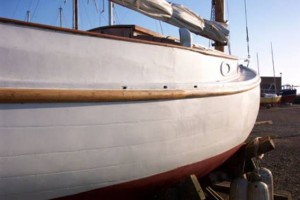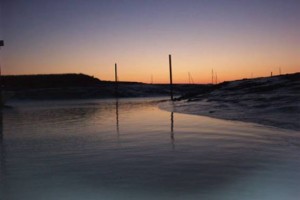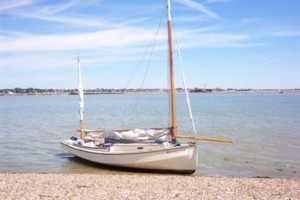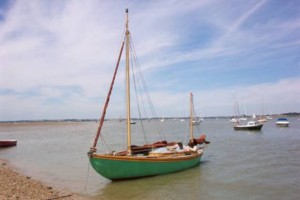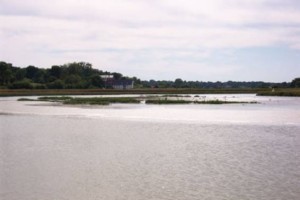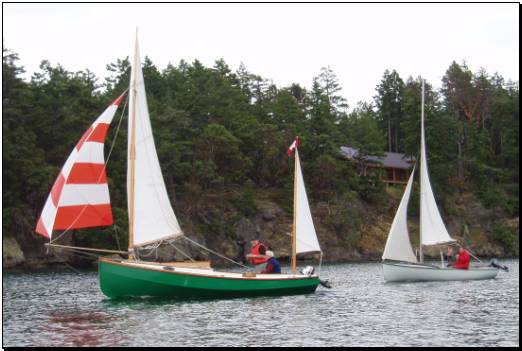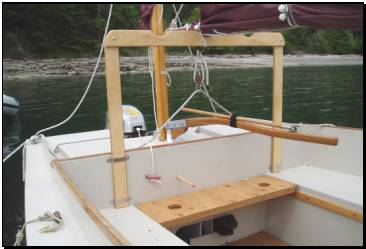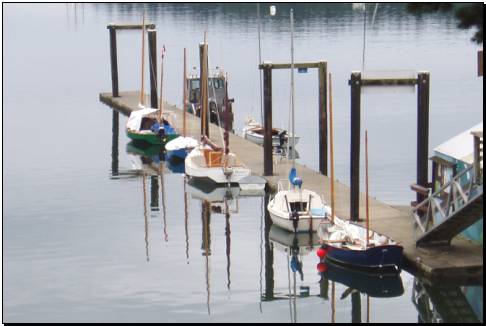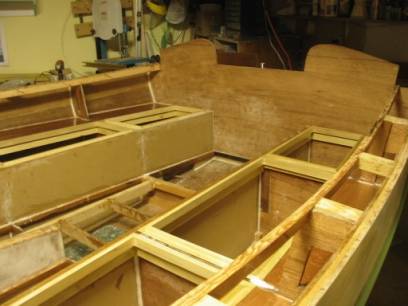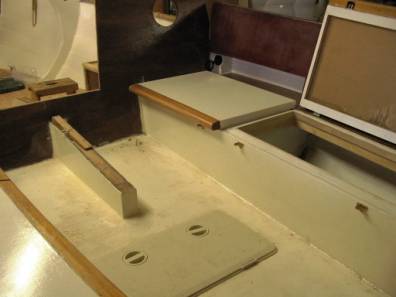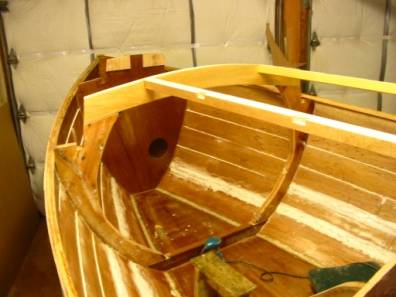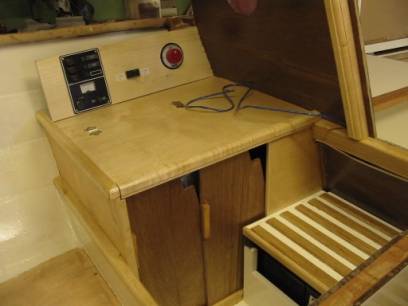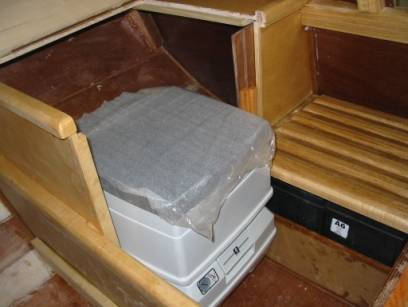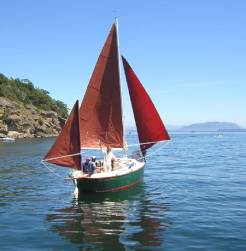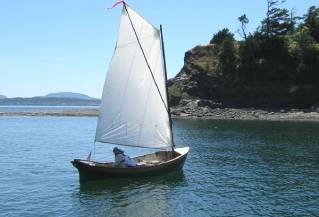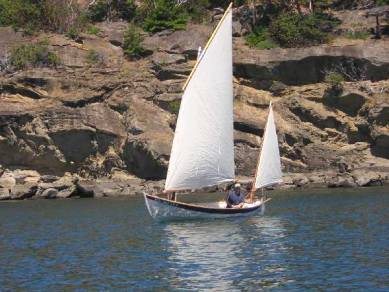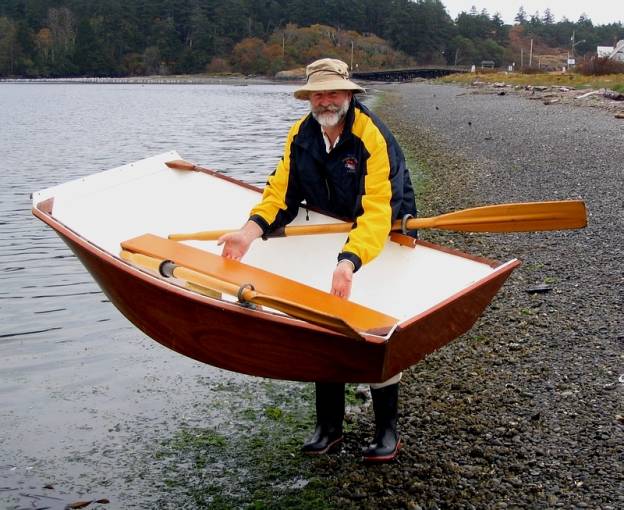Russellville 2006 – Richard Spelling
It was a dark and stormy night (well, a gray and drizzly afternoon, anyway) when I took off for Arkansas. I’d been anticipating this messabout for quite some time, as due to scheduling conflicts I had missed the annual Rend lake messabout.
I work the weekends, four ten hour days on and three days off. For this trip I had taken four days off straight, so I had a nice break from work. Mini-summer vacation you might call it.
A couple days before the messabout I cleaned the boat out, scrubbed it down, and loaded up with provisions and bedding for one person. I left the cold box stuff in the house, but other than that I was ready to go that Wednesday. I had earlier decided to go up a day early get in some alone time with the boat, and take a break from things.
It was a four hour drive to Russellville pulling the boat. My little Toyota Tacoma with four banger would do fine if the speed limit was still 55, or if the ground was level, but it kind of bogs down on the hills. Not too surprising, the last trip I weighed the boat, and it came in at just about 3500lb. This is precisely the towing limit on the Tacoma, coincidentally. I got to the lake after dark and put the boat in with the mast still folded and the sail cover still on. Motored to the little cove where we’d had the messabout last year. It was kind of hard to find in the dark, but between the flashlight and the GPS, I found it.
Temperature was nice, lots of wind, but the little cove sheltered me from the wind and waves, with just the occasional boat wake to bounce the boat around.
Set anchor and slept to the sound of rain hitting the cabin. I have learned from previous trips that I sleep much better in dry clothing, so I changed into PJ’s and set the fan up. Temp was nice outside, but the fan is a lifesaver inside the cabin when you are trying to sleep. Need to get me one that turns slow and quietly, and runs off of 12v. The one I use is a cheap 115v fan from WalMart. I run it off the inverter, which works fine, but adds inefficiency and some extra noise to the cooling equation.

The Arkansas state park authority had saw fit fill in the nice sandy beach with a six inch layer of red clay. This was the type of red clay that sticks to your feet in huge globs and won’t wash off in the water. I swear they dug it out from the ground at my house. I decided everyone at the messabout should write them a nice thank you letter for this.

Picked up a block of ice from the marina, and poked around a bit. Decided if I wasn’t here for the messabout, the marina would be a nice place to stick the boat. Might also make a decent hideaway in a storm. Any port in a storm, and all that.
Windy and rainy all day Friday. People started to arrive in the afternoon, mostly old hands from the last Russellville messabout.
Ate dinner at Phil’s house, checked out his boat projects. Took the camera, but forgot to take pictures!
Re-anchored the boat next to the riprap. I was fine where I was, but my anchor line was blocking access to the little cove, didn’t want it chewed up by a propeller.

In the evening, the wind shifts to blow directly into the cove, boat starts bouncing around, but anchor seems to be holding. I don’t worry about it to much, and go back to sleep.
A little after 9am on Saturday I wake to the sound of the wind howling outside the boat.
Suddenly, the wind is blowing hard enough to pull the windward anchor out. The boat is pulled around by the limb/tree line and starts bouncing up against the rocks.
I quickly change out of my PJ’s into some jeans and go for a swim (well, a wade, anyway) to reseat the anchor. While I’m in the water, I hear what I think is either the wind whistling through the power lines, or some kind of warning siren. Turns out it was the latter, and there were tornadoes just a couple of miles away. Fun. I go swimming during a tornado warning.
After a couple tries at reseating the anchor with no success, I move to plan B. I unhook the shoreline, pull in the anchor rope, start the engine from the water, and hop onto the boat. A few hundred feet down the shore from the messabout is the marina where I got the ice yesterday.
I head there. I’m bouncing around quite a bit, with the wind and the waves coming from directly abeam, but Schrödinger just shrugs it off and keeps on trucking. I beach the boat on the grass in the shelter of the marina’s breakwater, make breakfast, put the bedding away, and tidy up.
When the wind calms down I head back to the cove. Engine quits on the way, but restarts with a couple pulls. This is a Nissan I bought brand new. It started stuttering after I had had it about six months, like it has a fuel problem or something. I have a $30 marine water filter on the gas line, and use gas stabilizer religiously. I’ve taken the carb apart and cleaned it, to no avail. I’ve even had Max the outboard guru look at it. Some kind of fuel problem is his diagnosis, but we aren’t sure what it is.
A few more people arrive, we visit some, it’s basically raining all day.
Several of the folks call it for rain, and head home. I decide this is a good idea, and follow suit.
***
Sailing Sylvester – Richard Elkan
This weekend provided the best sailing I have ever had on board Sylvester. I left the decision to go for the weekend until the last minute, so I was on my own.
The forecast was easterlies both days F4-5 on Saturday F3-4 on Sunday. Solid sun both days with temps in the high 20’s (C that is Jamie!) I got off to a bad start. Held up for an hour on the A12 because of a vehicle fire, then in my haste to get away, realized I had left the boat cover on the mooring pontoon, so had to go back for that. Loosing more time.
The idea was to sail up the Blackwater to stay the night at Maldon, alongside friends on their 25′ Hunter Horizon. Well the delayed start meant I missed the last of the flood up the river and was now punching the tide all the way. The wind was dead behind me and with one reef in I was making good progress. Really choppy with the wind over tide, with Sylvester doing her best to pound the chop into submission. I’d been going for a over two hours, when it dawned on me, even if there was enough water to get up to Maldon, it would be tricky to avoid running aground without a crew to help with the pilotage. I didn’t fancy spending the night on the mud in the middle of the Blackwater.
So I decided to turn back and use the ebb to get me back to Brightlingsea. Only when I went about did I realize how strong the wind was. Beating into this was really uncomfortable (OK scary). I was faced with reefing again or putting into Bradwell Marina that was right abeam of me. I choose the latter.
Not the prettiest of places, but the local pub was excellent and the views over the river were lovely in the evening light. I chatted with a couple who were camping on their Drascombe and pointed out to them the amazing 1908 Crosby Catboat that was in the boat park (22′ long and displaces 5.5 tons!!!!!)
As the tide fell and the light faded, the Marina took on a somewhat Lunar or maybe WWI Landscape appearance, what is Essex mud all about?
As I was having breakfast, this Guy waved to me and came down the pontoon and introduced himself as John Sheldrake, who apparently had tried to buy Sylvester from you Bill at some point. I had met him before on the water, but had a good chat to him this time, Boy does he regret not buying Sylvester! He seems to buy and sell a boat about once a year from what I could make out. He told me that the wind yesterday had risen to F6 on the river, so my decision to get into Bradwell was one of my better ones!
As the forecast was F3-4 for the Sunday. I decided to let the flood build up to mid tide, to get the strongest assist with the beat back. It was glorious as I left at 7am and found myself beating straight into the suns reflection as it rose in the sky, bloody perfect!!!!! After and hour or more I shook out the reef as the wind eased and got back to Brightlingsea in good time. Bought a few bits and bobs in the chandlery including a small collapsible anchor for holding onto a beach. Then I motored across the Colne to Colne Point and beached Sylvester on the rising tide and made lunch. It was hot!!! Here’s the star of the show.
So there I was having lunch when this amazing looking craft beached along side. It looked fabulous, So I went over to admire her and on explaining that Sylvester was mine the other owner asked if my boat was a Chebacco, the second person I have met who knew what he was looking at. Anyway this 26′ Canoe Yawl turns out to be rather interesting. he explained that it was designed by one (Englishman) Albert Strange in the 1890’s, as a commissioned design, it was never built. The outlines were discovered quite recently and published in Wooden Boat Magazine (I think) Anyway the interest was such that the magazine asked one Phil Bolger to draw up building plans for the craft, which he did. As far as the proud owner knew his was the only boat to have been actually built from these plans. By the way the craft was only launched on Saturday, after a 3 year build. It is of totally traditional build and is magnificent. I couldn’t bring myself to ask how much it might have cost. It was built by a local builder at Rowhedge on the Colne, once a very famous boat-building centre, right up to 1964.
Later in the day
So after this interesting diversion I headed up the river Colne to moor up at Rowhedge for an afternoon pint. A very gentle sail after the rigors of Saturday, although I was getting fried! Whilst up at Rowhedge I took a side trip up the very grand sounding Roman River. This is actually just a creek about a mile long and only navigable at high water and then with only shallow draught craft. It terminates in a superb water mill. It was like traveling through a Constable painting. You can just see the Mill in the distance here.
So then back to Brightlingsea for the end of the trip. I had noticed that my Yamaha outboard was not pumping it’s usual vigorous stream of cooling water, more like a trickle. Sure enough, just as I cleared the narrow section of water through Wivenhoe (it was a dead beat and a very narrow channel) the motor gave out. I am not good with motors!
Still from here on I could beat back, as I had the ebb with me. Lovely sail back to Brightlingsea. But on arriving there my worst fears were realized. The ebb was now pouring out of Brightlingsea creek and the easterly meant the wind was right on the nose. I tried everything I could to get back up the creek, but I just couldn’t make any ground against the mid tide. All I could do is beat back and forth across the creek entrance, much to the incredulity of the huge number of boats coming back for the night and wondering just what this fool was doing! I was also in danger of being pushed back onto the mud all around the ever narrowing navigable channel as the water dropped. However the busy traffic meant the Harbour Master was still around, so a call to him on the VHF meant after about another 30 mins of standing off and on (as I believe is the correct naval term) he came and towed me to my mooring. I was VERY grateful! I was also totally knackered, It was gone 7pm by now and I had been solo sailing for 12 hours, albeit with 2 stops.
On the pontoon I managed to extract the tiny amount of weed that was blocking the cooling system and the engine ran as sweetly as ever. Then just a two hour drive home. Barbara hardly recognized me as I was several shade darker than when I left, My body was still on deck but my eyes told me I was home, Wonderful!
Cheers for now
Richard
***
Montague Harbour Small Boat Rendezvous – Randy Wheating
The first annual Montague Harbour Small Boat Rendezvous was held on Galliano Island, one of the British Columbia Gulf Islands, May 27-29, 2006.
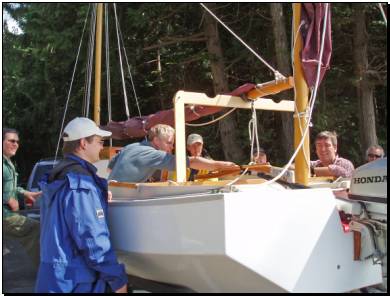
Boys and Boats Getting Together….
Mainlanders came via ferry while those from Vancouver Island traveled under their own steam (or wind). Throughout Saturday folks arrived at the beautiful Montague Harbour Marine Park. One of the last participants to arrive was Jamie Orr and his father Les aboard Wayward Lass. The gathered fleet was sailing around the harbour when we picked up Wayward Lass on the VHF and sallied forth to escort her in. This was a good opportunity for Jamie to show off his stylish orange and white striped jib.
Wayward Lass Shows Her Jazzy Jib
Buster was also testing a few new additions that included extension to engine shifter, pull start extension cord (shortens reach required) and boom gallows.
The group pretty much took over the park dock and those not sleeping aboard set up tents at the campsites on the bluff overlooking the dock. Saturday evening was spent eating, drinking and sharing stories around the campfire.
We were honored to have Cal Cran and his friend Mike join us from Alberta with Cal’s Bolger Bobcat. They included the rendezvous in their weeklong road trip (as well as several rounds of golf) to view and sail some real life Chebaccos as Cal is planning to build his own in the near future.
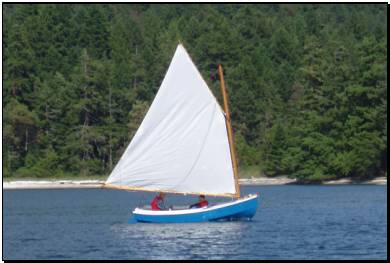
Gatito Leads Her Big Sisters
Next morning Curtis and Ben departed early as they had a full day of travel ahead. After a leisurely start the rest of the fleet headed north into Trincomali Channel where we saw off Ratty, Quill’s dory and Kirk’s Davidson 17 as they headed for home. Those remaining spent another pleasant night in the campground before departing via ferry or sail home.
List of Attendees:
Wayward Lass Chebacco Jamie and Les
Bluster Chebacco Lisa, Randy, Jacob and Sam
Gatito Bobcat Cal and Mike
Paper Nautilus Siren 17 Curtis and Ben
Unnamed Davidson 17 Kirk and Mike
Ratty Lugger Tad and son
Unnamed Mower dory Quill and crew
***
“Three Rivers” is Ready – Almost – Ben Ho September 2006
One year after the hull was done and turned over, hopelessly over-budget, and more or less on schedule, Three Rivers is finished except for her spars. She’s based on a modified design by Phil Bolger and has a slightly longer and higher cabin, with a cockpit with a raised, self-draining floor.
Cockpit
This picture shows the cockpit framing and the seats. Structural frames are made of white oak or Doug fir. The sides, seat cover, and floor are made of ¾” Crezon boards (the type used for outdoor signs).
Cockpit completed and painted. The floor is glassed such that the fabric pattern is left to form a non-skid surface. Each side has three storage compartments that are isolated and water-tight. I used a high quality weather strip around the perimeter of each hatch as a seal. Much cheaper than neoprene strips but not as strong, but I don’t think I need to turn this into a submarine. A Bomar floor hatch provides access to additional storage area underneath, hopefully it’s also water-tight.
Cabin
The forward bulkhead is left in place to form a water tight compartment which divided into upper and lower halves. The upper area is the chain and anchor locker. The lower area is stuffed with floatation foam. Both are accessed through a screw-hatch. The structural framing is made of Doug fir, and maple is used for ceiling beams. The fir is painted over; the maple is varnished.
The cabin bunk/floor is in. This is a V-berth that can comfortably sleep two. The floor can be easily lifted up by taking out a few screws and has good storage space underneath, but I decided that I already have plenty of storage and I put floatation foam in there instead. The total volume of foam should just about offset the 250 lb of battery so that the boat is unsinkable.
On the starboard side in the cabin is the electrical panel, workspace (chart table?), with a Potti hidden. The steps are also the battery compartments, with 2 banks on either side of the center board trunk. The electrical panel controls the motor, battery charger, nav lights, cabin light, and has a cig. lighter plug for powering other sources (such as a DVD player). The four marine deep cycle batteries provide a total of about 300 Amp-hours of juice for a 65 lb thrust Minkota electric outboard. When fully charged the batteries should be able to run over 20 hours at 50% power. I want to avoid using smelly gas motors if I can help it! The battery weighs 250 lb and is also the ballast. I read that adding ballast won’t improve the initial stability of the Chebacco, but it should help to right the boat from a knock down.
The table top lifts up, and the Pottti slides out, for a relatively comfortable position….
The port side has a small galley, with a storage unit and stove top for putting a small propane stove.
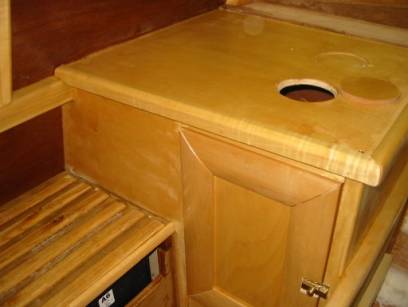
Exterior
I installed two portholes to bring in more light through the main bulkhead. They are made of Lexan with a plywood frame. There’s also a compass mounted. The bulkhead is inclined at a forward angle for aesthetics. The incline (instead of simple right-angle) added a staggering amount of complexity that was not foreseen….Won’t do that again!
I added a bowsprit so that I can have a jib. Holding a jib sheet can be a bit of work in a blow, so I also added this snubbing winch.

One of my proud creations – a forward hatch built of Lexan and cedar. The cedar frame curves to fit the exact curvature of the cabin roof.
Here she is – almost ready to leave the garage where she’s been evolving for two years. I need to move her out of the garage to make room for the spars, which should keep me busy this winter. How to lift her up from the strong-back and put her onto the trailer? I am still figuring that out…

***
Wayward Lass at Sucia 2006 – Jamie Orr
It was that time of year again – July, time to pack up Wayward Lass and head for Sucia State Park in the San Juan Islands. Due to some trailer problems, we made our departure this year from Oak Bay Marina in Victoria, as close as you can get to the very bottom of Vancouver Island. Surprisingly, this only added 3 nautical miles to our usual 25, as measured on the chart.
My dad, who usually joins me on these trips, was off on one of his periodic trips to Scotland, so Chris Bennett filled his berth. Chris is an experienced Chebacco sailor, having initially partnered Fraser Howell in building and sailing Itchy and Scratchy in Halifax. Alan Woodbury came up from Port Townsend to be a third hand – he’s temporarily boatless but had a yen to see Sucia again.
We cast off at 8:00 am with a light following wind. This summer I’ve been learning to use the asymmetrical spinnaker I made last year. I set this on a ten-foot pole — it can point over the bows like a very long bowsprit or off to the side to catch a following wind. It’s a pain to rig, and the “shroud” angle when used as a bowsprit is too small for more than light winds, but pays off in the right conditions. As soon as the sail was up we could feel it pull us along.
Even flying the spinnaker it was a leisurely trip up Haro Strait. We stayed away from the American side as the big ships use that side and we were happy to keep our distance until we had to cross their path to enter Roche Harbor. Coming from the south, we took Mosquito Passage, a reasonably well marked but twisty entrance – Chris had traversed it before and confirmed that yes, the marks were in the right places and the channel really does do that.
Once through Customs, the wind and current took us out of the harbour, but once out in Spieden Channel the wind left us to spin slowly along on the flooding tide where Kirk Coleman, also bound for Sucia, motored up from behind in his Davidson 17 to say hello. A breath of air tempted both crews to try sailing again, but the wind was only fooling around so we woke up Honda and motored the rest of the way. Once at Fossil Bay we stopped on the beach to unload – there was already a good crowd of small boats there.
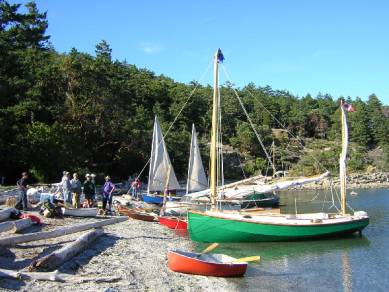
Here’s the beach at Fossil Bay, withWayward Lass in the foreground. The twin sails behind are on Joe Nelson’s Core Sound 20, Blew-by-You
Afterwards we anchored out and rowed ashore in my new and tiny tender, Tartlet, to cook our dinner. We had to cook up the spaghetti with canned ham for meat as I appeared to have forgotten the sausage, but it tasted fine anyway. We opened a bottle of wine, which further improved it.
In the evening a sizable group gathered around the campfire, sampling Chuck Gottfried’s homebrewed ale. But we still managed to take Tartlet out to Wayward Lass without tipping – no small feat for two grown men in a less-than-six foot dinghy! Alan had brought his tent in order to sleep ashore so we were spared the problems of ferrying three.
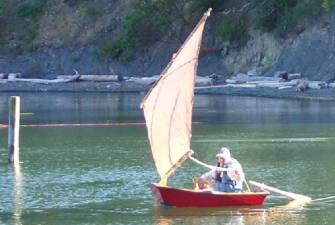
This is Trot, tender to Full Gallop and sister-ship to Tartlet. Chuck believes that anything that floats should sail too!
Next morning we were supposed to hold the Sucia Challenge, supposed to be a round the island race – but you can’t sail without wind. By 11:00, however, there was enough wind to tempt some of us out of the bay. Full Gallop and Wayward Lass (with Frank Mabrey and Alan Woodbury for crew) headed out, along with Bryan in his Benford catboat. Full Gallop immediately took the lead thanks to her big jib, but once Wayward Lass started flying her spinnaker the tables turned – although it was still a close contest. FG had the advantage to windward, but WL could put up more sail area on a reach or a run. We really need to hold that race we keep talking about!
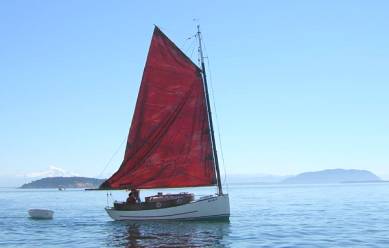
Bryan’s Jay Benford catboat. She’s strip built, I believe she was the model for a fibreglass mould used to produce a series of these boats.
About then James McMullen came out in Rowan, so we sailed over to say hello. We discovered that Rowan, a stretched Oughtred JII, is one fast boat – for the most part she had no trouble keeping up with the Chebaccos, both of which spread more sail than she does.
The wind was light and only present in patches – it was easy to sail out of it, then it took a lot of effort to get back to it, so we didn’t try to go far. However, three other crews were more determined. Aurors, Windisfree and Barquita came out and let the current waft them off to the east. Hours later they returned from the west, having successfully circumnavigated the island with only a little help from the infernal combustion motor.
Coming back in, we passed the Calkin Wherry and the Nimble out sailing too.
James let me beg my way onto Rowan to see how she went. Once I learned to use the push-pull tiller stick, I found her very easy to sail. James says he has used that type of steering on three double-enders now and wouldn’t have anything else. It allows him to steer from almost anywhere on board, making for better weight distribution. I took a try with the oars too, and found that for a twenty-footer she rows very easily, one man could row her all day without straining. A great boat, and fast – if I didn’t already have a Chebacco, I would be seriously tempted!
Saturday night was our first-ever organized happening, a wine and cheese event. We spent the whole evening around the table and campfire enjoying good food, good drink and good company. We even had a couple of speeches, including the presentation of a six pack of Chuck’s home brew to the round-the-island sailors. Lynn Watson picked up his guitar and gave us an eclectic mix of tunes and songs. Unfortunately, (or maybe fortunately!) no one could remember all the words to Barrett’s Privateers – there’s your homework for next year, ladies and gents.
Sunday was another day of light wind. A few crews had to leave in order to be at work on Monday morning. Bluster and Java went north, Josh and Anika Colvin’s Montgomery 15 and the Nicolaisen family’s Nimble went south, for Anacortes. Rowan, the Benford catboat and the Calkins wherry also turned southwards for Bellingham, although Bill and Sandy in the wherry planned to stop overnight at Matia Island, just a couple of miles to the southeast. Kirk Coleman also left on Sunday, heading back to Vancouver Island.
A few folk took advantage of the trails to go hiking. Three of us went out to the clifftop on the southernmost point on the southwest side of Fossil Bay. As we took in the view, we engaged in much deep philosophical discussion but were unable to come up with a good reason why so many power cruisers appear to be modeled on hi-tech running shoes.
Looking for a simpler view of life, we returned to the beach and went sailing. Terry and Patricia Lesh joined Alan and I in Wayward Lass, and sailed out in company with Joe Nelson’s Core Sound sharpie, Blew-By-You. At some point, I don’t remember just when, the expedition developed into a race around Matia Island, with Blew-By-You andWayward Lass setting off first, with Full Gallop, who had come out earlier, chasing us from windward.
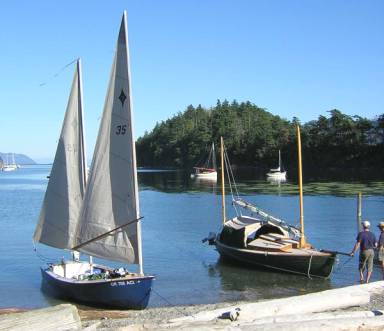
I don’t have a picture of Blew-by-You sailing, but here she is at the beach, beside Lynn Watson’s modified Drascombe Peterboat,Katie Mae.
A potentially awkward situation, but we were saved from any embarrassment by the competition losing interest. Chuck, in Full Gallop, went off to the east and appeared to be caught by the north-flowing tide. Joe, in Blew-By-You, landed at the nearer (the northwest) end of Matia instead of going around. In Wayward Lass we fired up the engine and motored slowly down the southeast shore. At the other end we found a long narrow bay with a shingle beach, where we beached ourselves to go ashore and stretch our legs. This would make a good anchorage for two or three small boats as long as the wind didn’t blow from the southeast.At first, Wayward Lass’ chances looked good. With the spinnaker, we had the edge on the Core Sound in the light wind, and Chuck was still well behind although closing fast. However, Wayward Lass’ skipper made a major tactical error, sailing into the lee of Matia, losing the wind and any hope of finishing, never mind winning.
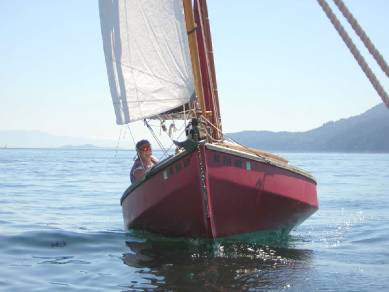
Here’s my favourite view of Full Gallop. Unfortunately, I’m seeing more and more of her stern these days. That big jib is very effective….
After our run ashore, we continued around the island, turning into the bay at the northwest end for a closer look at a small power cruiser that Terry lusted after. We saw Bill and Sandy’s wherry anchored in this bay, but didn’t see them. Then it was back to Sucia for dinner and another evening around the campsite, although with a now much-reduced company.
Next morning was going-home time. We packed up and loaded Wayward Lass, then motored out of Fossil Bay until next year. We waved goodbye to the guys going south then pointed our own bows west, shutting down the motor shortly after. We had 5 to 8 knots of wind, going against the tide at about 45 degrees. The 2 miles or so to the tip of Orcas Island, where the south-bound tide split south-east and south-west, was slow going, but once past that we had the southwest-going current with us. The wind was also improving, so we were soon moving well. Chuck and Dean in Full Gallop and Darrell Pepper in Barquita were in sight to the north, heading for Pender Island and a few days’ cruising in Canadian waters. They were close-hauled and having a tougher time of it than we were. We hailed Full Gallop on the VHF to say good-bye, but it was a short call as they had to sign off and concentrate on some big waves just about then.
Once past the tip of Orcas, we were following the same path as the tide which was ebbing strongly. As we passed through Spieden Channel, the wind was blocked entirely by the land and our speed through the water dropped to zero, but over the ground we were still making 5 knots! This highlighted the importance of using the tides in these waters, and not trying to fight them. As soon as we were through Spieden, the wind came back, now from the south. This put us close hauled on the starboard tack, pointing about southwest, but a new current was coming down a different route, from the north west, combining with our course through the water to make our GPS track due south, right down the middle of Haro Strait.
This lasted until the tide changed, but by then we were close to the Vancouver Island shore, where a stray current continued south (this was according to the current atlas, a very detailed, hour by hour tidal prediction). This eddy helped us along the shore as we short-tacked to stay out of the main current of what was now a north-bound flood tide. The last obstacle was getting through Baynes Channel, the north entrance to Oak Bay and one where the tide flows very strongly. Wayward Lass punched through the eddy line off the point like a whitewater kayak, immediately turning away from the wind to let out the sheets. We crept along close to the rocks until we were out of the current, then sailed on home. When we docked, we had sailed 28 miles in 7 hours.
And that was the end of our part in another great Sucia rendezvous.
PS: During that last evening around the fire, the annual Shipyard Raid, from Silva Bay to Port Townsend, (see http://www.shipyardraid.ca/) came up for discussion. Before we knew it, we were talking about holding our own version of a raid – a cruise in company where each crew would be responsible for its own safety and supplies, and with less emphasis on racing. We’ll post some details, once we figure them out, on the Small Boat Rendezvous website at http://www.members.shaw.ca/jamie.orr/.
PPS: I don’t always carry my camera, and I didn’t take pictures of every boat at the rendezvous. More pics can be found on the website above. Follow the Sucia link and click on Who’s Coming.
***
Tartlet, a Chebacco-sized tender – Jamie Orr
At the Sucia small boat rendezvous this year I gave Tartlet, my new tender, her first real test. Here’s my description of her and how she performed.
Tartlet was conceived shortly after designer and friend Chuck Merrell put up free plans for Apple Pie, an eight foot dinghy, on his website. I asked him if chopping off two feet would result in a workable boat, as I wanted a tender that would fit crosswise inside Wayward Lass’ cockpit for travelling. He promptly replied with a six foot design that we called Apple Tart – being a smaller Apple Pie. (And Tartlet is even smaller, hence the name.)
I should have done my measuring first, before I emailed Chuck. When I did measure the space available, I found that a slightly shorter dinghy might be easier to lift in and out of the cockpit without marking up my paint, so when I cut out the pieces I chopped 3 inches off the bow. (I put back an inch or two by raising the transoms, for appearance sake). I did the chopping by drawing the sides and bottom as designed, then measured back three inches along chine and sheer for the finished shape. The forward transom was redrawn using the actual measurements of the chopped pieces. So Tartlet’s lines are true to the design, they just end three inches sooner than planned.
To keep her a light as possible, the hull was made from 1/8th inch ply. Instead of the “normal” thwarts shown on the plans, she has a single seat running lengthwise. No frames were used, instead I laminated the gunwales to provide just enough stiffness. She finished out at 30 pounds exactly.
How she performs:
Towing: She tows very nicely. The towing ring is right at the bottom of the forward transom, bolted through the seat support. She has a lot of rocker and when towed behind the outboard at 5 knots the bow comes up and she skims along on the after part of her bottom. She didn’t take in any spray, and also stayed dry when towed while we were sailing close-hauled with a reef tied in, over a steep chop.
Rowing: She goes extremely well for such a tiny beast, she has no skeg but rows nicely without it. Her small size is a bit of a problem to me as I’m six feet tall with arthritic knees, so I sit sort of side-saddle on the fore and aft thwart. My friend Chris, three or four inches shorter, can sit in the usual position. With two, she works really well. For this, the oarsman sits aft against the stern transom, rowing her backwards, and the passenger sits forward, facing him. With a transom at either end, rowing backwards doesn’t look or feel odd at all. A heavy passenger can sit closer to the centre to keep the boat trimmed.
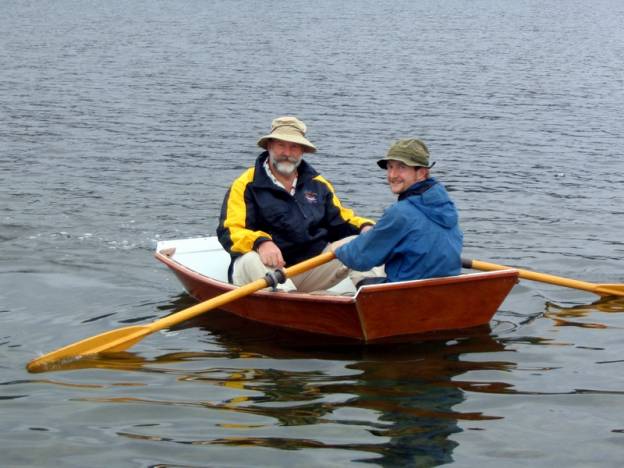
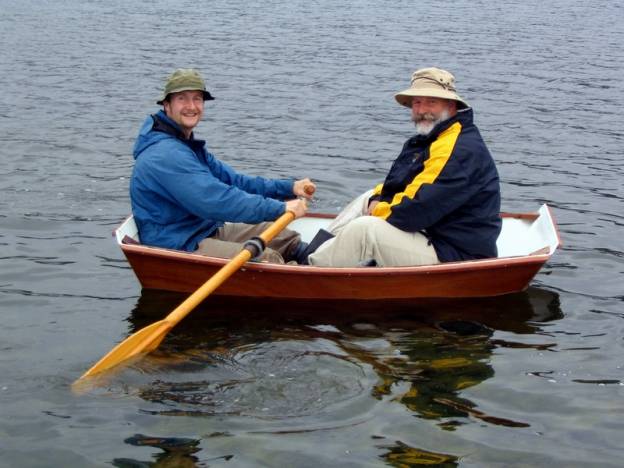
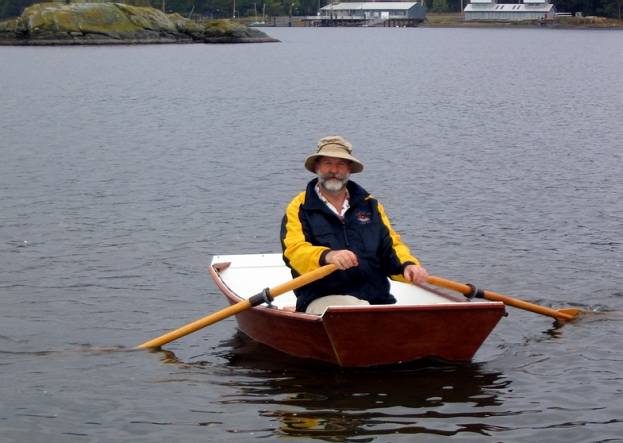

Stowing: She’s intended to fit across the cockpit, and she fits very nicely, taking up about half the space. I may add a very small skeg, just deep enough so I can cut out a hole to use in lashing her down. With that, and the towing ring at the other end, she’d be well secured. I raised the transoms slightly and left the tops of the straight so they sit firmly when she’s upside down. Despite all this planning, though, I’ve found that she fits inside my van so I have just been carrying her there.
And sailing (!): I didn’t build a sailing rig, but I shared the Apple Tart plans with Chuck Gottfried, which I shouldn’t really have done (Chuck Merrell is a nice guy and didn’t ream me out as he was entitled to). Anyway, Chuck G. built his Apple Tart (called Trot) to the plans, then went on to add a small lugsail and leeboard. He uses an oar for a rudder.Trot sails surprisingly well, I’ve tried her myself and she even sailed to windward for me. If you are a bit more limber than I, you could have some fun with this and perhaps give Chuck G. a little competition!
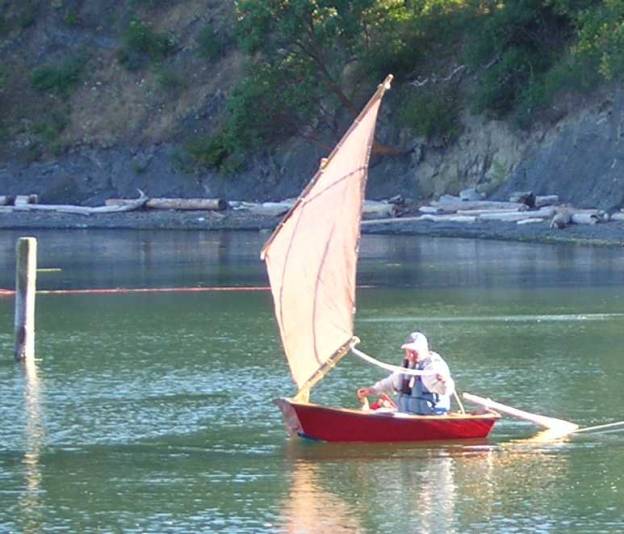
Conclusions: The Apple Tart design may not be for everyone – there’s not a lot of room and any six foot dinghy is going to be on the tender side. However, it’s a great little boat for a six footer. My Tartlet does everything she was intended to do and does it well, including carrying 400+ pounds of skipper and crew ashore and back at Sucia, numerous times, which I thought was pretty good going.
Anyone interested in building their own Apple Tart should email Chuck Merrell at chuck@boatdesign.com. If asked nicely, he might even customize it for you. Or you could ask about the original Apple Pie, or the ten foot version he designed for Bill Samson they called Peach Pie.






